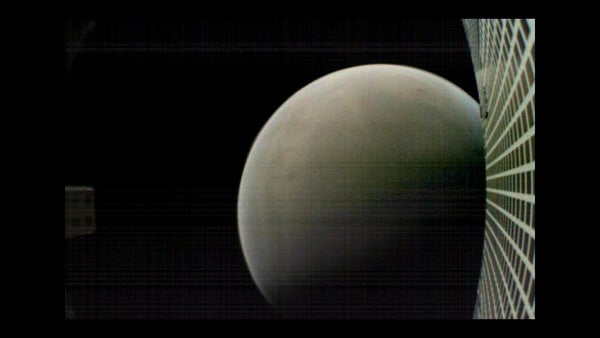The era of the interplanetary cubesat has definitively dawned.
Less than seven months ago, no tiny spacecraft had ever voyaged beyond Earth orbit. But two briefcase-size probes just blazed a trail all the way to Mars, covering 301 million deep-space miles (484 million kilometers) and beaming home data from NASA’s InSight lander during the latter’s successful touchdown on the Red Planet Monday (Nov. 26).
The tiny NASA craft, known as MarCO-A and MarCO-B, even photographed Mars and helped researchers collect some data about the planet’s atmosphere during their flyby, mission team members said. [NASA’s InSight Mars Lander: Full Coverage]
On supporting science journalism
If you're enjoying this article, consider supporting our award-winning journalism by subscribing. By purchasing a subscription you are helping to ensure the future of impactful stories about the discoveries and ideas shaping our world today.
“This team of really mostly part-timers on the project has proven the technology that we were trying to demonstrate with this mission,” MarCO chief engineer Andy Klesh, of NASA’s Jet Propulsion Laboratory (JPL) in Pasadena, California, said during a post-landing press briefing at JPL on Monday.
The main goals of the $18 million MarCO project (whose name is short for “Mars Cube One”), Klesh added, involve “being able to support a large craft like InSight, in order for it to perform its fantastic science,” as well as showing “that we can take a smaller, focused more risk[y] mission out into the solar system,” Klesh added.
The mission also aimed to “bring the community that we have built for these small spacecraft along with us,” he said. That community included many young, early career engineers and scientists, a number of whom are still university undergraduates, Klesh said.
The MarCOs launched with InSight on May 5, atop a United Launch Alliance Atlas V rocket from Vandenberg Air Force Base in California. That was a first as well; every previous NASA interplanetary mission had lifted off from Florida’s Space Coast.
The MarCOs weren’t attached to InSight. They made their own way to Mars, so they could get into position for their data-relay work. This was an important task, because no NASA Mars orbiter would be in position to immediately relay InSight entry, descent and landing info home.
MarCO is a demonstration mission testing three main technology components: a special high-gain antenna, a miniature radio the size of a softball and a cold-gas propulsion system that uses the same stuff found in fire extinguishers.
This last bit explains the duo’s nicknames, “WALL-E” and “EVE.” In the 2008 Pixar film “WALL-E,” the eponymous robot uses a fire extinguisher to zoom around space and chase after its more technologically advanced pal, EVE, who has an onboard propulsion system.
MarCO-A (EVE) and MarCO-B (WALL-E) both launched with off-the-shelf cameras. EVE’s didn’t work very well, but WALL-E managed to capture shots of Mars from afar and close in. Indeed, the mission team has already released a gorgeous photo of the Red Planet taken by WALL-E from a distance of about 4,700 miles (7,600 km) on Monday, just minutes after InSight’s triumphant touchdown.
WALL-E also attempted to photograph Mars’ two tiny moons, Phobos and Deimos, NASA officials said in a statement Wednesday (Nov. 28), without revealing whether the little probe succeeded in this endeavor.
We could see more of WALL-E’s photos soon. The MarCO team was initially focused on getting InSight data down via the two two cubesats. But Klesh and his colleagues now have time to dive more deeply into the MarCO data, which includes vital-sign information, as well as images collected by WALL-E and some EVE radio science. [NASA’s InSight Mars Lander: Amazing Landing Day Photos!]
EVE flew behind Mars during Monday’s encounter, so the MarCO team is investigating how the Red Planet’s atmosphere distorted the probe’s signals. Such information can reveal details about atmospheric thickness and composition, mission team members said.
“Not only did we do technology demonstration, not only were able to get images back, but we are able to do some science there as well," Klesh said.
Though WALL-E and EVE aced their main missions and are now streaking away from the Red Planet, their work may not be done. The duo could observe an asteroid or other object in the future—if they approach such a body closely enough and if the team gets money for an extended mission, John Baker, JPL’s program manager for small spacecraft, told Space.com.
Other bantam spacecraft will soon follow the MarCOs into deep space, if all goes according to plan. A phalanx of cubesats are manifested on Exploration Mission-1 (EM-1), the first flight of NASA’s Space Launch System megarocket, which is currently targeted for June 2020.
The main goal of EM-1 involves sending NASA’s Orion crew capsule (which won’t be carrying any passengers) on a three-week cruise around the moon. The cubesats are hitching a ride and will do a variety of different things. For example, the Lunar Flashlight probe will hunt for water ice on the moon’s surface, Near-Earth Asteroid Scout will solar-sail to a space rock and investigate it up close, and BioSentinel will study how deep-space radiation affects DNA and DNA-repair mechanisms.
That’s just a taste. More than a dozen cubesats will fly on EM-1; you can learn more about some of them here.
“Cubesats have incredible potential to carry cameras and science instruments out to deep space,” Baker said in Wednesday’s NASA statement. “They’ll never replace the more-capable spacecraft NASA is best known for developing. But they’re low-cost ride-alongs that can allow us to explore in new ways.”
The $850 million InSight mission—whose name is short for “Interior Exploration using Seismic Investigations, Geodesy and Heat Transport”—will spend nearly two Earth years studying Mars’ interior composition via a burrowing heat probe and a suite of supersensitive seismometers. The results should reveal key details about the formation of rocky planets, mission team members have said.
Copyright 2018 Space.com, a Future company. All rights reserved. This material may not be published, broadcast, rewritten or redistributed.
